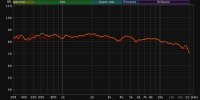I don't know if you consider me an evangelist, if I had what you want I would give it to you but I don't.However, I do have some skepticism of any signal manipulation based on listening position measurements above the transition region, and that increases when only a single point is measured. That could be assuaged to some degree if one of the evangelists would post standard data showing what the systems do to the direct field output of the loudspeakers. None of them seem willing to do it, unfortunately.
I can show you an outdoor vs indoor on axis. I think they are reasonably similar, not all speakers would be though. Anything else would be BEM or Vituix simulation as measuring 7 ft tall speakers as CTA-2034 is difficult.


